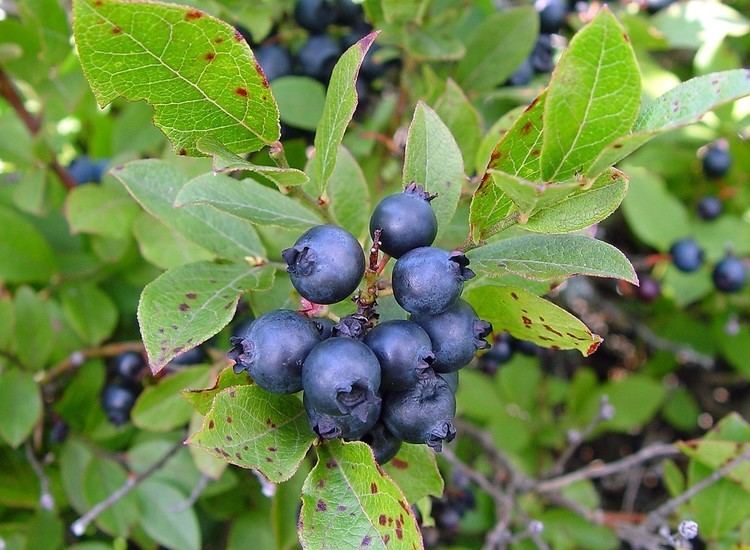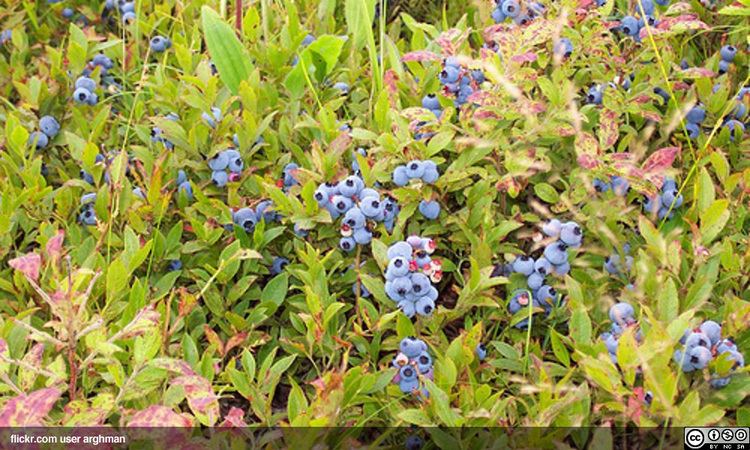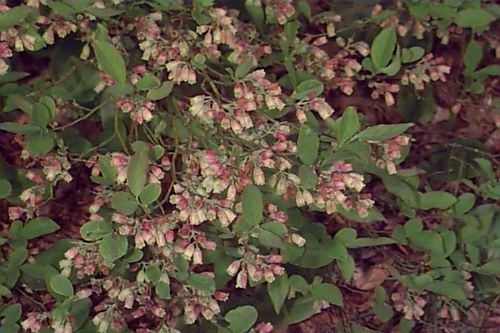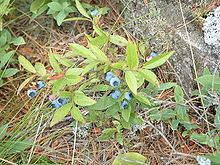Rank Species | Genus Vaccinium Higher classification Blueberries | |
 | ||
Similar Blueberries, Vaccinium corymbosum, Vaccinium virgatum, Vaccinium myrtilloides, Ericaceae | ||
Vaccinium angustifolium mp4
Vaccinium angustifolium, commonly known as the wild lowbush blueberry, is a species of blueberry native to eastern and central Canada (from Manitoba to Newfoundland) and the northeastern United States, growing as far south as the Great Smoky Mountains and west to the Great Lakes region.
Contents
- Vaccinium angustifolium mp4
- Etymology
- Description
- Interesting facts
- Distribution and habitat
- Pollination
- Production
- Pruning
- Products
- Health Facts and Information
- References

Etymology

The species epithet angustifolium is a combination of the Latin words angustum meaning 'narrow', and folium meaning 'leaf'. It shares this epithet with other species of plants including Epilobium angustifolium.
Description

Vaccinium angustifolium is a low spreading deciduous shrub growing up to 60 cm tall, though usually the plant averages about 35 cm tall or less. The rhizomes of the Vaccinium angustifolium can lay dormant up to 100 years and when given the adequate amount of sun light, soil moisture and oxygen content they will sprout. The leaves are glossy blue-green in summer, turning a variety of reds in the fall. The leaf shape is broad to elliptical. Buds are brownish red in stem axils. The flowers are white, bell-shaped, 5 mm long. The fruit is a small sweet dark blue to black berry, chalked full of antioxidants and flavonoids. This plant grows best in wooded areas, old abandon farm yards or open areas with well-drained acidic soils. In some areas it produces natural blueberry barrens, where it is practically the only species covering large areas.

You can have several buds on a healthy stem and each bud can open up and have several blossoms. A blueberry field that has full plant coverage can have as many as 150 million blossoms per acre.

The Vaccinium angustifolium plant is fire-tolerant and its numbers often increase in an area following a forest fire. Traditionally, blueberry growers burn their fields every few years to get rid of shrubs and fertilize the soil. In Acadian French, a blueberry field is known as a "brûlis" (from brûlé, burnt) because of that technique, which is still in use.
Interesting facts

Distribution and habitat
The native plant lowbush blueberry is also grown commercially in Canada, Maine, and Massachusetts, mainly harvested from managed wild patches. It is also a favorite of recreational berry pickers, black bears, coyotes, racoons, foxes, porcupines, whitetail deer and birds. To help keep the unwanted individuals out of the blueberry fields and from damaging or eating the crop growers will fence their fields and connect power or use an automated surround sound speaker system called a bird squawker. This bird squawker is set up on a timer system to send out predator bird sounds during the day and at night the system can be programmed to discourage night time crop feeders.
Pollination
During the harvest year blueberry growers rent honey bee hives to put in their fields for pollination. These hives are placed in the fields at a density range of anywheres from 1-8 hives per acre. The hives are placed in the fields at 10-20% bloom allowing the bees to have enough forage in the field rather then going else where to forage. Hives on average are left in blueberry fields for 2 weeks allowing the bees to pollinate the variety of clones in the field all of which bloom at different times during the two week period.
Some growers also use bumble bees along side of the honey bees in hopes of maximum pollination. Bumble bees will fly in colder and wetter weather conditions then the honey bee will, they also pollinate in a different way then the honey bee.
Production
In 2006, production of wild blueberries in Quebec has reached 70 million pounds (31.8 million kg). From this, 55 million pounds (2.2 million kg) were produced from the specially equipped blueberry farm (Bleuetière), and 15 million pounds (6.8 kg) were collected in the forest. The vast majority of blueberries, or 67.5 million pounds (30.7 million kg), has been marketed under various processed forms, and particularly in the form of frozen wild blueberries. In 2016, the production of wild blueberries was the highest ever in Quebec reaching 115 million pounds. The production reached 60 million pounds in Nova Scotia in 2016. The plants rough acreage in Nova Scotia is 46 thousand.
Pruning
Native Americans regularly burnt away trees and shrubs in parts of eastern Maine, in order to stimulate blueberry production. Modern farmers use various methods of burning or mowing to accomplish this. There are a number of methods grower use to stimulate blueberry production on their land such as burning the land or by using a flail mower, bush hog, lawn mower, etc. to cut the plants off as close to the ground as possible without scalping the land. These procedures are used to promote the spreading of rhizomes under the soil. Some growers use a sickle bar mower in the fall after the crop has been harvested to mow the plants off leaving roughly 1 to 2 inches of stem so the growers can then burn the remaining of the plants in the spring using less fuel for the fire.
Products
Roughly 90% of wild low bush blueberries are sold IQF (Individual Quick Frozen). Some berries are fresh packed during harvest season and sold at farm markets and grocery stores. There is a 100% pure wild blueberry juice on the market. This tasty little powerful fruit can be used to make a wide variety of food products such as blueberry smoothies, a blueberry sauce for waffles, blueberry grunt, blueberry lemon loaf, blueberry crisp, blueberry muffins, blueberry jam, blueberry martinis, and can be used for a topping on cereal or yogurt.
Health Facts and Information
Wild blueberries are a good source of Vitamin C and dietary fiber. They contain no fat, sodium or cholesterol and are only 80 calories per cup of berries. Recent studies have shown that the pigments in the skin of the berries can provide health benefits to the consumer. These pigments are called anthocyanins which contain antioxidants. The antioxidants in the berry help to fight compounds called free radicals which can cause cancer, heart disease, other diseases and premature aging. In a study by the USDA wild blueberries were found to have the highest level of antioxidants out of 40 fruits and vegetables.
Often as individuals age they can develop or suffer from memory loss and experience a decrease in their motor abilities. In a study conducted by the USDA it has been shown that wild blueberries may reverse these problems and help fight the effects of aging. The antioxidants found in the skin of the wild blueberries help the skin to maintain elasticity over time.
Urinary tract infections are a common health problem that trouble some individuals and may be able to be prevented by eating wild blueberries. Tannins, which are found in wild blueberries and cranberries, can prevent the bacteria that cause urinary tract infections from attaching to the wall of the bladder and urinary tract. Thus allowing them to pass through the body without causing any harm.
Due to the dark pigments in red wine caused by anthocyanins which are the same pigment as in wild blueberries it is proven to lower the risk of heart disease. Making it a reasonable assumption to expect that wild blueberries may have the same effect on lowering the risk of heart disease.
